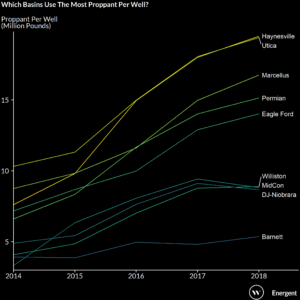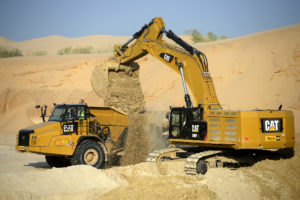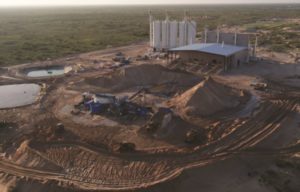Basin frac sand mines may face a shakeout in the last quarter of 2019.
By Paul Wiseman
The oil and gas economy is always compared to a roller coaster ride, but nowhere in the sector has the ride been crazier over the last decade than in frac sand.
Until the early 2000s, frac sand mining was only a tiny operation. With the advent of the frac’ing boom, sand mines in Illinois and Wisconsin brought forth millions of tons of their benchmark Northern White.
As transportation costs became more of a factor, serviceable sand was found in McCulloch County, Texas, near the towns of Brady, Voca, and nearby Mason. Several mines were racing to meet demand by 2012-2013. The future for operators, employees, and investors looked bright and sustained.
Then there was the downturn, and although most mines survived, it was difficult going—shrinking business and profit margins led to layoffs.
The downturn was short-lived and by 2017 talk at the Dairy Queen in Brady was more positive.
But—by 2018 producers noticed the piles of sand scattered around Monahans and wondered, “What if….?”
Within a year, seeing that local sand could save them $400,000-$600,000 per well over even the relatively closer Brady sand, the sea changed again, with 19 mines opening in the Permian in 2018.
Brady took another hit, but was still hoping for a return to profitability until the Permian slowdown in drilling earlier in 2018.
A combination of factors has led to an 8-10 percent downturn in hydraulic fracturing activity over the first half of 2019, and the ripple effects extend to frac sand shipments even in Permian mines. Those ripples could lead to the closing of some newly-opened frac sand mines in the Permian later in 2019, said Todd Bush, head of NAM & Unconventionals at Westwood Global Energy Group in Houston.
“There certainly will be a decline in the amount of frac sand being used in the first half of [2019] compared to last year at this time,” he said. “Sand companies are shutting down or idling some plants.”
Bush has seen the Brady/Voca closures happen “fairly rapidly in the last couple of months [June/July 2019].
“Now our attention is turning to [the question of] which Permian mines will actually go to intermittent production or idling of some production,” he said.
Economics indicate that some amount of production needs to come off the market in order to keep remaining mines at the break-even level.
At-risk mines would likely have two points—low volume of business and low levels of capitalization. A single-mine owner or a mine backed by a smaller private equity (PE) firm could be in the latter category.
One option for staying open might be to ship sand just two days a week, although Bush said the logistics there would be challenging. “I think it would be very interesting to see how some of these companies can manage that. It would be exceptionally difficult.”
Serial idling might be an option for a company with multiple mines in the Permian. Mine A could be closed in for a while, then reopened while mine B is closed, with employees rotating as needed.
In what may be very unfortunate timing, two more mines are currently under development, Bush said, but “we actually don’t think those mines are going to come online.”
With huge investments in equipment and in land location and preparation involved in opening a sand mine, most operators and investors look at a 30-year operational plan in order to maximize ROI. When asked if the sudden sand market changes of recent years have dampened investor enthusiasm, Bush said, “We’re talking to investors that are looking at what other options are around,” such as lending or extending lines of credit or other ways to be involved financially without the long-term commitment of investing directly in a company.
While some of the slowdown is attributable to takeaway capacity shortages, Bush has seen similar activity drops in other markets with in-basin sand, including Oklahoma’s SCOOP/STACK [a 40 percent drop in drilling activity there].
Northern White is still shipped to areas such as the Bakken, Colorado’s DJ Basin, and, in the East, to the Marcellus and Utica. A small amount of Northern White does still come to the Permian, he said.
Still, as with most oil industry subsectors, the industry looks to the Permian as the bellwether of the frac sand market.
In the second half of 2019 Bush’s group sees Permian drilling activity levels as flat overall. Majors, including Exxon/Mobil and Chevron, may be the exceptions. Estimates are that Permian mines shipped 39 million tons of sand in 2018, and Bush believes 2019 amounts will be about the same.
Industry leader Hi-Crush led the way to the Permian, opening the first in-basin mine there in July of 2017. The next year, almost 20 more mines would open in the Permian. The company previously had operated mines Wisconsin, extracting what’s known as northern white. Hi-Crush’s CFO, Laura Fulton, explained the thinking and the market forces that preceded that decision.
“Things had changed in the Permian Basin with respect to the kind of sand, the mesh sizes they were using in the completion process,” she said. In 2010-2012 Basin producers felt coarser grade sands such as 20-40 or 30-50 were what was needed for a successful frac.
The downturn of 2015-16 caused operators to look at saving money by using cheaper sand—a product in which a large portion of the cost was in transportation for that which comes from distant Wisconsin. “Some of the cheaper sand was the finer mesh sand because there was more of it available out of the Wisconsin plant. People were using that just as a way to lower costs,” she said.
“Lo and behold, they found that it actually improved the production from the wells by using more and more sand and using the finer mesh sand. So, all of a sudden, 40-70 sand and 100 mesh sand started being utilized in the Permian Basin in 2016-17 when it just hadn’t been used before.”
The amount of sand blowing across West Texas is the stuff of legend—and the man Hi-Crush bought their reserves from had studied the sand. He’d determined that “it was high quality 100-mesh sand,” Fulton said.
While the greatly reduced freight costs were one driver, the science of local still had to work for the frac process.
“It was because of how the well completions change over time to use more and more sand, but also more and more of the finer mesh sand that, all of a sudden, all of the sand that was available in the Permian Basin became a viable product to use in well completions.”
 As for questions about the long-term benefits of finer sand, Fulton said, “We’ve been operating out there for two years, and the customers that we’re dealing with are very pleased with the results coming from their wells.” She added that customers in that time have seen no degradation in the production decline curve using in-basin sand.
As for questions about the long-term benefits of finer sand, Fulton said, “We’ve been operating out there for two years, and the customers that we’re dealing with are very pleased with the results coming from their wells.” She added that customers in that time have seen no degradation in the production decline curve using in-basin sand.
The company’s customers’ main questions involve crush strength, economics, and production levels in comparison to northern white. Fulton said basin sand is almost as strong as northern white, basin sand is much cheaper in transportation costs, and production levels have been more than satisfactory compared to northern white.
As for the effect that’s had on Wisconsin mines, Fulton said they have idled one, but the others are still running. Some higher-cost mines run by smaller companies have been shut down or idled.
While some northern white is still coming to the Permian and to the Eagle Ford, she said much of what was coming here is now going to the Marcellus, Utica, DJ, Bakken, Powder River, and other basins that do not have a local sand option.
The northern white that is still coming south is largely being delivered to deeper wells in the southern Delaware, where producers don’t want to take any chances using anything other than sand that’s worked for them historically.
Demand in the other basins has picked up enough to make up most of the slack created by local sand in the Permian. “It’s been an interesting phenomenon to see how the supply has truly shifted to meet the demands, and then the supply itself has rationalized by taking out some of the higher cost production facilities so it’s the more efficient players like ourselves that are continuing to operate and do well in those markets,” she noted.
Hi-Crush dodged the Brady Brown bullet, mostly because they didn’t think it had sufficient crush strength. Since the mines themselves were crushed in the move to in-basin sand, that decision to avoid Brady looks even better now. Fulton attributed some of the Brady interval to the fact that, as sand demand grew in 2012-14, there was not enough northern white available, so producers were willing to gamble with a softer sand instead of waiting for supplies of sand from Wisconsin and other points north.
The company has yet to see a slowdown in demand from their Permian customers, but Fulton believes Q4 may be different. With faster drilling and completion methods and a squeeze on capex budgets, many producers will have depleted their drilling budgets early in Q4, meaning it will be January before they can start back up.
Fulton cited the company’s biggest issue as being—wait for it—hiring. “It has been interesting to try to attract the right kind of people and retain them in the environment we were in in 2017 and 2018 when there was a lot of growth. That has become a little bit easer as things have stayed steadier throughout 2019.”
Like other frac sand companies, Hi-Crush is working on solutions to road crowding, trucking safety, and efficiencies and other challenges presented by the widespread mining of sand that supports another mining industry, oil and gas.













